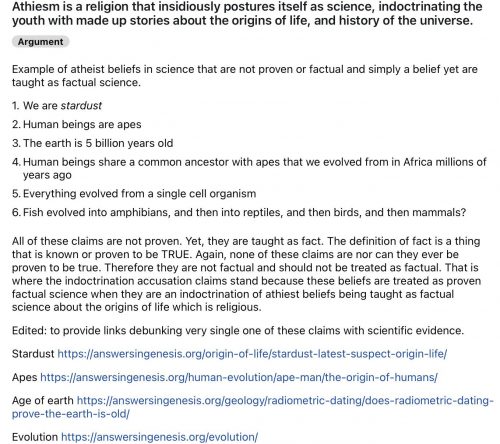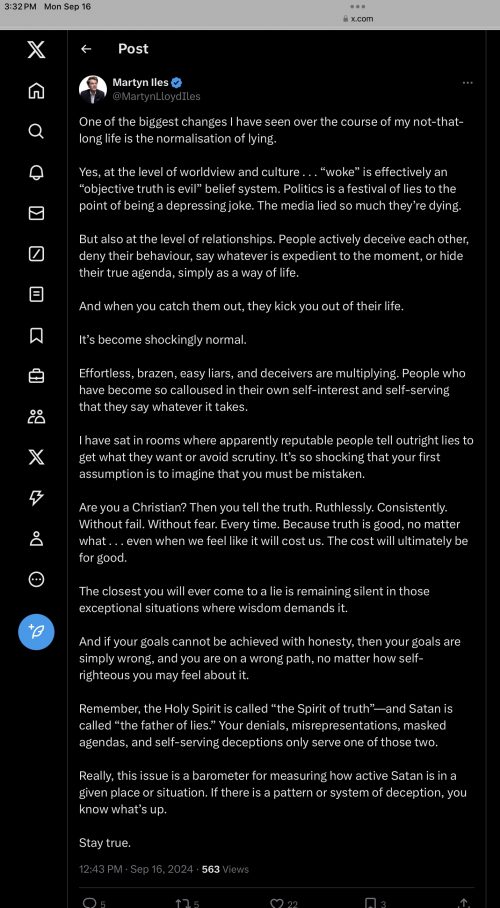Oh boy. There are places on the internet that are still full of arrogant ignorance. A creationist charged into a subreddit with some, ummm, assertions.

Athiesm is a religion that insidiously postures itself as science, indoctrinating the youth with made up stories about the origins of life, and history of the universe.
Example of atheist beliefs in science that are not proven or factual and simply a belief yet are taught as factual science.
Why is it that these guys who hate atheism so much don’t know how to spell atheism? That’s especially ironic given that nothing he complains about are actually tenets of atheism. His gripe is with science, not atheism — a great many religious people are entirely comfortable with accepting every idea on his list. It’s just that most (not all) atheists don’t have any problem with the authority of science, it takes a dedication to religious dogma to so readily accept counterfactuals.
Let’s look at his claims one by one.
1. We are stardust
This is not an atheist idea.
The base material of the universe is hydrogen — it’s mostly hydrogen. So the question is, where did the heavier elements come from? The religious belief is that a god simply poofed them all into existence. A better, non-miraculous explanation is that the process of nucleosynthesis, a fusion reaction that takes place in stars, built up the carbon and iron and oxygen etc. over time, and that these elements were scattered throughout the universe and used as building blocks for planets and people etc. We have evidence for nucleosynthesis. We lack evidence of divine poofing.
2. Human beings are apes
This is not an atheist idea.
Humans definitely belong in the ape clade — the morphological, genetic, and molecular evidence link us. If an alien were to classify and categorize life on Earth, they would group us with the other primates. There is no evidence to suggest that humans are discretely unique in a way that makes them non-apes. This is an old, failed argument by creationists that there is something in the human brain that isn’t shared with other apes.
3. The earth is 5 billion years old
This is not an atheist idea.
Go argue with the physicists and geologists. We know for sure that the Earth is older than 6000 years old, the usual number trotted out by creationists.
4. Human beings share a common ancestor with apes that we evolved from in Africa millions of years ago
This is not an atheist idea.
Geneticists and anthropologists have the details. We can, for example, measure the differences between the genomes of humans and chimpanzees, measure the rates of mutation and fixation, and estimate how long the two species have diverged. It’s millions of years. The anthropologists can tell us our ancestors were African. Where is the creationist evidence for, for example, the Garden of Eden or Adam & Eve?
5. Everything evolved from a single cell organism
This is not an atheist idea.
Likewise, we have evidence of all the shared commonalities between us and all other organisms. We have evidence of the processes that generate the differences. Common origin is the most parsimonious explanation. Meanwhile, the Christian Bible doesn’t even contain the concept of cells, or single-celled organisms. Would he like to argue with the evidence for cell theory?
6. Fish evolved into amphibians, and then into reptiles, and then birds, and then mammals?
This is not an atheist idea. It’s also not a scientific idea. It’s a creationist bogosity.
For someone trying to argue with evolution, he sure doesn’t seem to understand the theory. He presents a linear caricature of evolution, and claims that’s what we teach? Mammals didn’t evolve from birds, or from modern reptiles, or from modern amphibians, or modern fish. Come on, do better.
All of these claims are not proven. Yet, they are taught as fact. The definition of fact is a thing that is known or proven to be TRUE. Again, none of these claims are nor can they ever be proven to be true. Therefore they are not factual and should not be treated as factual. That is Where the indoctrination accusation claims stand because these beliefs are treated as proven factual science when they are an indoctrination of athiest beliefs being taught as factual science about the origins of life which is religious.
Allow me to quote one of the slides I present in my introductory biology class.
There is no such thing as “truth” or “proof” in science! All knowledge is provisional and subject to revision.
Scientists do use the word “fact”, but only in the sense that Stephen J. Gould defines:
In science, “fact” can only mean “confirmed to such a degree that it would be perverse to withhold provisional assent.” I suppose that apples might start to rise tomorrow, but the possibility does not merit equal time in physics classrooms.
This class has nothing to do with atheism; it’s not a subject we discuss at any point in the semester.
Another thing I teach:
Science is not a catalog of facts to be memorized.
Science is a process for acquiring and evaluating new knowledge.
Religion does the opposite of that; it’s an interpretation of a few old myths presented as inviolate dogma. There’s no way you can regard science as a religion.
And why is a religious dogmatist using “religious” as a pejorative?
He throws in a few references, but they’re all from Answers in Genesis, and therefore can be dismissed out of hand.









